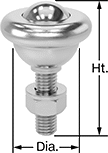Stud-Mount Ball Transfers


Install these ball transfers in a threaded hole or use a nut to secure.
Steel balls are durable. Stainless steel balls offer the most corrosion resistance. Nylon and polypropylene balls are nonmarking. Nylon is stronger than polypropylene. However, polypropylene resists chemicals better than nylon.
Ball transfers with an angled working orientation can be used to form support stands.
Capacity is given for the ball up orientation. Using these ball transfers in a ball down or angled orientation could reduce the capacity stated.
For technical drawings and 3-D models, click on a part number.
| Ball Dia. | Cap., lbs. | Ht. | Dia. | Working Orientation | Thread Size | Stud Lg. | Temperature Range, °F | Each | ||
Steel Ball | ||||||||||
|---|---|---|---|---|---|---|---|---|---|---|
Zinc-Plated Steel Housing | ||||||||||
| F | 1" | 270 | 1 25/64" | 1 3/8" | Ball Up, Ball Down, Angle | M8 | 1 19/32" | __ | 00000000 | 0000000 |
| H | 3/4" | 55 | 31/32" | 1 9/32" | Ball Up, Ball Down, Angle | M8 | 1" | __ | 00000000 | 00000 |
| H | 1" | 120 | 1 9/32" | 1 9/16" | Ball Up, Ball Down, Angle | M8 | 1" | __ | 00000000 | 00000 |
Stainless Steel Ball | ||||||||||
Zinc-Plated Steel Housing | ||||||||||
| H | 3/4" | 55 | 31/32" | 1 9/32" | Ball Up, Ball Down, Angle | M8 | 1" | __ | 00000000 | 00000 |
Stainless Steel Housing | ||||||||||
| H | 1" | 120 | 1 9/32" | 1 9/16" | Ball Up, Ball Down, Angle | M8 | 1" | __ | 00000000 | 00000 |
| H | 1" | 120 | 1 9/32" | 1 9/16" | Ball Up, Ball Down, Angle | M8 | 1 31/32" | __ | 00000000 | 00000 |
Nylon Plastic Ball | ||||||||||
Zinc-Plated Steel Housing | ||||||||||
| H | 3/4" | 40 | 31/32" | 1 9/32" | Ball Up, Ball Down, Angle | M8 | 1 31/32" | -22° to 128° | 00000000 | 00000 |
| H | 1" | 55 | 1 9/32" | 1 9/16" | Ball Up, Ball Down, Angle | M8 | 1" | -22° to 128° | 00000000 | 00000 |
Clean Room Stud-Mount Ball Transfers

Unlike most ball transfers, which have metal balls, these have a plastic outer ball that rolls on stainless steel inner balls, so there's no metal-on-metal contact that could create and release particles into your clean room. They've also been ultrasonically cleaned and then individually bagged to prevent dust contamination. These ball transfers were originally developed for the electronics manufacturing industry, where aligning glass layers in monitors and screens must be done without introducing dust. Use them to create conveyors, transfer tables, and material staging areas in your clean room.
Acetal ball transfers are best for light duty applications.
PEEK ball transfers withstand more wear and are more chemical resistant than acetal ball transfers, so they handle more demanding applications.
Vespel® polyimide ball transfers are nonconductive, which means they prevent stray electrical charges from passing between your material and equipment. They're best for moving glass and other material with a polished surface because they're smoother than acetal and PEEK ball transfers and won't scratch surfaces.
Thread | ||||||||||||
|---|---|---|---|---|---|---|---|---|---|---|---|---|
| Ball Dia. | Cap., lbs. | Ht. | Dia. | Working Orientation | Housing Color | Size | Pitch, mm | Stud Lg. | Temperature Range, °F | Environmental Rating | Each | |
Acetal Plastic Ball | ||||||||||||
Acetal Plastic Housing | ||||||||||||
| 3/8" | 1 1/2 | 9/16" | 21/32" | Ball Up | White | M8 | 1.25 | 15/32" | 0° to 175° | Fed. Std. Class 1,000 | 0000000 | 000000 |
PEEK Plastic Ball | ||||||||||||
PEEK Plastic/Stainless Steel Housing | ||||||||||||
| 3/8" | 2 1/2 | 9/16" | 19/32" | Ball Up | Beige | M8 | 1.25 | 15/32" | 0° to 260° | Fed. Std. Class 1,000 | 0000000 | 00000 |
Vespel® Polyimide Plastic Ball | ||||||||||||
Vespel® Polyimide Plastic/Stainless Steel Housing | ||||||||||||
| 3/8" | 1 | 9/16" | 19/32" | Ball Up | Brown | M8 | 1.25 | 15/32" | 0° to 200° | Fed. Std. Class 1,000 | 0000000 | 000000 |

























